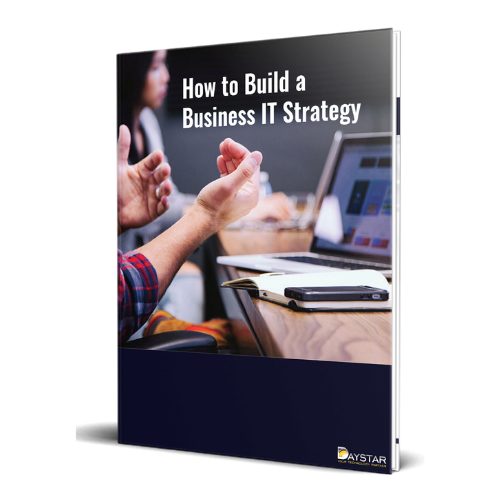As the summer comes to a close (boo!), our thoughts turn to crisp air, apple pie, football and… budget planning! It’s true! As we prepare to head into the last quarter of the year, it’s a good time to start IT budget planning for 2021. Today’s businesses have become more digital and use more automated processes than ever before. They rely on technology to support day-to-day operations and critical business needs. Deliberate technology planning and IT budget forecasting is extremely important to support the strategic direction of the business.
Is your business plan missing something?
Technology powers your business, but it can also hold it back. As your company grows, make sure your technology solutions can keep up and help you hit your goals. Don't be caught without a plan.
Some small and midsized businesses we meet with initially think that IT budgeting is only for “big” companies, CIOs and CFOs. Yet, when we help them implement strategic IT budget planning, they realize the positive impact it has on their ability to reach their strategic goals. The budgeting process for SMBs will vary in terms of formality and complexity. However, its impact is realized universally. We help businesses understand the process of budget planning in the following main areas:
2. How is an IT budget beneficial?
4. IT budget planning guidelines

What is an IT budget?
Many businesses are familiar with strategic budgeting. An IT budget is simply a financial representation of your technology plan. It should reflect the combination of your strategic business priorities and technology needs amid your business’ economic constraints.
To truly maximize the benefits of IT budget planning, it is important to tie the budget to your overall business strategy and defined goals. With our clients, we incorporate budget planning with our strategic technology alignment process to ensure all parties are working toward a common goal. We also tie budgeting to one, three, and five-year goals.
How is an IT budget beneficial?
There are three main ways a documented IT budget can benefit a business. The first advantage is increased visibility. As a numeric representation of your business’ strategic plan, your IT budget allows you to see where projected technology spending will be. Are you facing hardware expenditures due to end-of-life equipment? Is a major software migration on the horizon? Will you need to allocate dollars to new equipment for upcoming new hires? What other technology investments do you need to make this year?
By tracking all of your it spending and budget items, you gain visibility into areas that might require some changes or improvements that, in turn, create more efficiencies and savings to your bottom line. With increased visibility, your decision-making can be much more informed.
The second main advantage to IT budgeting is predictability. Mapping out technology expenditures equips you with a financial roadmap for next year’s spend. It minimizes the risk, hassle, and stress of last-minute emergency costs. And, because it’s planned ahead of time, it ensures you have the money on hand when you need it.
The final benefit has more to do with the mindset of your business. IT budget planning allows you to be more strategic and deliberate with the way you allocate funds to IT initiatives. The very process of budget planning lends itself to aligning your technology plan to your overall business plan. This ensures that you spend your dollars on the solutions that will help you achieve an outcome or realize a specific goal, rather than blindly invest on solutions with no defined outcome.
When you look back and review a strategic IT budget, you should be able to measure and track the impact of your IT spend. Track savings from new processes and efficiencies to help guide future budget planning.
IT Budget Components
 Now that you know what it is and why you need one, the next question that stymies SMBs is what to include in an IT budget. Technology is so pervasive throughout our organizations that it can seem daunting to try and break it all out into financial line items. We advise our clients to compose their budgets with two main components: ongoing costs and project expenses.
Now that you know what it is and why you need one, the next question that stymies SMBs is what to include in an IT budget. Technology is so pervasive throughout our organizations that it can seem daunting to try and break it all out into financial line items. We advise our clients to compose their budgets with two main components: ongoing costs and project expenses.
Ongoing IT Costs
Ongoing costs are operational costs that are predictable in manner and consistent over time. They include things like:
- IT support costs: this may be employee compensation if you handle IT internally or support contract costs if you outsource your IT to a managed IT service provider
- Hardware: upcoming infrastructure costs, usually based on an equipment lifecycle refreshment calendar
- Software: this can include software licenses, subscriptions, support, and maintenance
IT Project Expenses
Project expenses are the one-time costs associated with upcoming IT projects. Projects are tied to and prioritized in your strategic IT roadmap to provide visibility into what technology projects require funding and when.
If projects are handled internally, be sure to outline the entire cost of the project, including project management, prep, installation, testing, and training. If you outsource your IT projects to a third party, this will likely already be done for you.
IT Budget Planning Guidelines
Budget planning is often looked upon as an overwhelming task that is dreaded by most people. But, there are ways to make it easier and, perhaps not exactly fun, but definitely liberating once it’s complete. Some ways you can improve the process are:
Start Early
Budget planning is a process that covers lots of details, requires research, and involves many parties. It is also one component to your overall business budget. Start the budget process early to ensure you have the time you need to create an accurate and complete IT budget. This not only alleviates any uncertainty over technology expenditures, but also instills confidence in future planning. Trust me, procrastinating budget planning only makes it harder.
Ongoing Communication
IT budget planning in particular impacts virtually all other aspects of your business. The support and projects you are funding concerns the company as a whole. If you are planning to implement cloud file sharing, don’t wait until the final budget presentation to communicate that. The need for new technology initiatives should not only be documented in your strategic IT plan, they should also be familiar to the organization’s leadership team with an understanding of the need for and benefit of the funded project. Communicating early and often makes the budget approval process go much more smoothly.
Don’t Copy & Paste
Technology is dynamic and new solutions and security needs are changing constantly for the modern business. It is not enough to simply update last year’s budget. The previous plan should be reviewed and analyzed in terms of success, but it is not enough to just tweak it. As mentioned above, your budget should be aligned with your business IT roadmap and reflect the items you need to reach desired outcomes.
Rolling Forecasts
As 2020 has certainly taught us, business and IT needs change quickly. Consider using rolling forecasts to amend budgets and provide a more agile approach to IT budgeting. Instead of producing a static annual budget, a rolling forecast provides a tool that leads you to revisit and update your budget throughout the year. This might be done biannually, quarterly, or even bi-monthly according to your business model or needs.
IT Procurement: Leasing vs. Buying
For many SMBs, cash flow is an important consideration. Unfortunately, a proposed IT project that is desperately needed by an organization is sometimes not funded due to cash flow constraints. Consider leasing equipment rather than purchasing outright. Leasing results in less up-front costs and predictable expenses. And, your team will benefit from up-to-date technology as equipment is continuously replaced on schedule. Leasing equipment allows a small business to keep up with its competition and benefit from the tools and technology they need to operate at top efficiency.
Strategic IT Roadmap Alignment
It’s been said before, but so important that it needs its own bullet. Align your IT budget to your strategic IT roadmap, which in turn should align to your overall strategic business plan. Your budget should communicate the financial investment required to enable your business to meet objectives, achieve goals, and realize growth.
Track data to prove ROI
Hand-in-hand with strategic alignment, track your budget performance to analyze results and determine the ROI of your business IT plan. This helps you identify areas where more or less investment is needed and keeps you on track to meet projections. It also extremely useful data to have when you begin to plan subsequent budgets and lobby for new project approvals.
IT budget planning may seem like an unwanted task on your to-do list. But, with proper consideration and preparation, it can be a very powerful tool for your business. Make sure it is part of the strategic planning process and aligned with your organization’s needs and goals.
Interested in learning more about how IT budget planning and strategic technology alignment can help your business? Talk with our team today.
Follow Our Learning Center for the Latest Developments in Technology and IT Support!
 |
||














